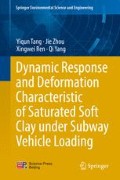Abstract
This chapter primarily conducted the finite element analysis of the dynamic response of soil around the tunnel under dynamic load induced by the subway train; the main work and conclusions are summarized as below:
-
1.
This chapter analyzed the mechanism of the generation of dynamic load induced by subway train and simulated it by programming in ANSYS.
-
2.
According to the field investigation and data from the boreholes, we developed a 3D finite element numerical model by inputting the relevant data.
-
3.
For obtaining accurate results without too large computational domain, artificial boundary was applied to simulate the soil body in the discretization of this model.
-
4.
The dynamic response of the soil in the model was consistent to the data obtained from the field test. And the results were proved effective and reliable.
-
5.
According to the calculation results, σ ′ z propagates further in vertical direction, while σ ′ x propagates further in the horizontal direction. Furthermore, the influence range of the dynamic load was determined by this model.
Access this chapter
Tax calculation will be finalised at checkout
Purchases are for personal use only
References
Andersen L, Jones CC (2006) Coupled boundary and finite element analysis of vibration from railway tunnels—a comparison of two and three-dimensional models. J Sound Vib 293(3):611–625
Balendra T, Koh CG, Ho YC (1991) Dynamic response of buildings due to trains in underground tunnel. Earthq Eng Struct Dyn 20:275–291 (in Chinese)
Cheng B (2003) Study on the settlement of shield tunnels due to metro train’s vibrating loads. PhD dissertation, Tongji University (In Chinese)
Feng JH, Yan WM (2008) Numerical simulation of the random vibration load of the train. J Vib Shock 27(2):49–52 (in Chinese)
Feng JH, Yan WM, Chen XM (2007) Contrastive analysis of the different load simulation methods. Railw Eng 10:79–81 (in Chinese)
Gao F (1998) Analysis of dynamic responses of a railway tunnel subjected to train loading. J Lanzhou Railw Inst 17(2):6–12 (in Chinese)
Huang JH, He CH, Yang GT, Liu WD (1999) FEM analysis of the vibration wave in the foundation. J Vib Shock 18(1):38–43 (in Chinese)
Li DW (1998) A deterministic analysis of dynamic train loading. J Gansu Sci 10(2):25–29 (in Chinese)
Liang B, Cai Y (1999) Dynamic analysis on subgrade of high speed railways in geometric irregular condition. J China Railw Soc 21(2):84–88 (in Chinese)
Liu JB, Lv YD (2000) Study on an analysis method of dynamic soil-structure interaction based on interface idea. In: Chen ZP, Jiang JJ (eds) Research reports of structural engineering and vibration, vol 5. Tsinghua University Press, Beijing, pp 1–17 (In Chinese)
Luo YY, Gen CZ (1999) Influence of track state on vertical wheel/track dynamic overloads. J China Railw Soc 21(2):42–45 (in Chinese)
Pan CS, Xie ZG (1990) Measurement and analysis of vibrations caused by passing trains in subway running tunnel. China Civil Eng J 23(2):21–28 (in Chinese)
Pan CS, Li DW, Xie ZG (1995) The study of the environmental effect of the vibration induced by Beijing subway. J Vib Shock 14(4):29–34 (in Chinese)
Saeed M (2008) Finite element analysis-theory and application with ANSYS, 3rd edn. Upper Saddle River, Prentice Hall
Wang XC, Shao M (1997) Basic principle and numerical method of finite element method, 2nd edn. Tsinghua University Press, Beijing
Wang FC, Xia H, Zhang HR (1999) Vibration effects of subway trains on surrounding buildings. J Beijing Univ Technol 23(5):45–48 (in Chinese)
Wang XL, Yang LD, Gao WH (2005) In-situ vibration measurement and load simulation of the raising speed train in railway tunnel. J Vib Shock 24(3):99–102 (in Chinese)
Xia H, Zhang N, Cao YM (2005) Experimental study of train-induced vibrations of environments and buildings. J Sound Vib 23(3):1017–1029
Xie WP, Sun HG (2003) FEM analysis on wave propagation in soils induced by high speed train loads. Chin J Rock Mech Eng 22(7):1180–1184 (in Chinese)
Xu ZY, Shen ZJ (1981) 2-D dynamic analysis of effective stresses of seismic liquefaction. J East China Collage Hydraul Eng 3:1–14 (In Chinese)
Yan WM, Zhang W, Ren M, Feng J, Nie H, Chen JQ (2006) In situ experiment and analysis of environmental vibration induced by urban subway transit. J Beijing Univ Technol 32(2):149–153 (in Chinese)
Zhang YE, Bai BH (2000) The simulation of the vibration load on the tunnel induced by subway train. J Vib Shock 19(3):68–78 (in Chinese)
Zhang YE, Pan CS (1993) Tests and analysis of the dynamic response of tunnels subjected to passing train load. J Shijiazhuang Railw Inst 6(2):7–14
Author information
Authors and Affiliations
Rights and permissions
Copyright information
© 2014 Springer-Verlag Berlin Heidelberg
About this chapter
Cite this chapter
Tang, Y., Zhou, J., Ren, X., Yang, Q. (2014). Finite Element Modeling. In: Dynamic Response and Deformation Characteristic of Saturated Soft Clay under Subway Vehicle Loading. Springer Environmental Science and Engineering. Springer, Berlin, Heidelberg. https://doi.org/10.1007/978-3-642-41987-4_5
Download citation
DOI: https://doi.org/10.1007/978-3-642-41987-4_5
Published:
Publisher Name: Springer, Berlin, Heidelberg
Print ISBN: 978-3-642-41986-7
Online ISBN: 978-3-642-41987-4
eBook Packages: Earth and Environmental ScienceEarth and Environmental Science (R0)

